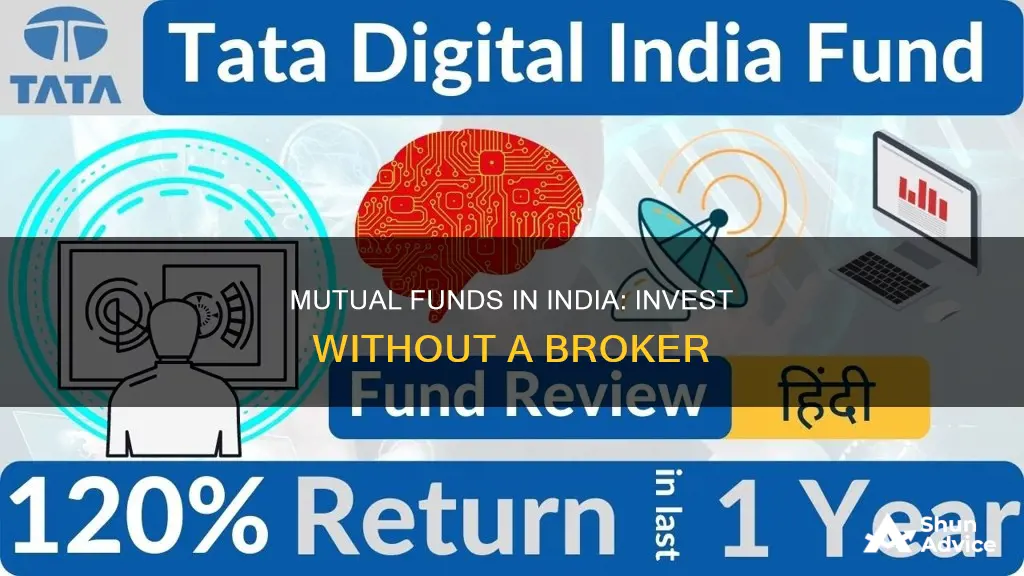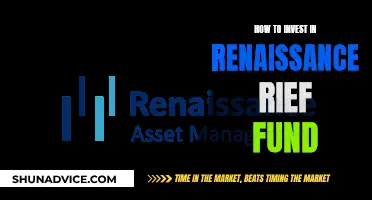
Investing in mutual funds in India has become increasingly popular, with total assets under management (AUM) reaching nearly Rs 38 lakh Crores by the end of March 2022. There are two main ways to invest in mutual funds: through a broker or agent, or directly. While brokers can provide valuable advice and support, investing directly in mutual funds can save you money on commissions and fees. Direct investment in mutual funds can be done through the offline mode or the online mode. In the offline mode, you would need to physically visit the office of the Asset Management Company (AMC) and complete your KYC (Know Your Customer) process. The online mode, on the other hand, offers more convenience and allows you to invest through the AMC's website, mobile apps, or online platforms provided by SEBI-Registered Investment Advisers.
| Characteristics | Values |
|---|---|
| Investment options | Mutual funds can be classified into three categories: equity, debt, and hybrid. |
| Investment process | There are two primary modes of investing in mutual funds: offline and online. |
| Investment methods | Individuals can invest in mutual funds through the Asset Management Company (AMC) or fund house website, mobile apps, demat account, third-party web portals, or banks. |
| Requirements | Individuals must complete their Know Your Client (KYC) or e-KYC requirements before investing in mutual funds. |
| Advantages | Mutual funds offer risk diversification, professional management, a range of solutions, tax benefits, and liquidity. |
What You'll Learn

Know Your Customer (KYC) compliance
To be KYC-compliant, investors must submit a range of supporting documents for identification and address verification. These typically include:
- A recent passport-size photograph
- Proof of identity (e.g. passport, PAN card)
- Copy of PAN card
- Proof of address (e.g. Aadhaar card)
- Duly filled KYC form
The KYC form can be obtained from the offices of Registrars and Transfer Agents (RTAs) or Asset Management Companies (AMCs). Investors can also seek assistance from a mutual fund distributor or financial advisor to fulfil these requirements.
Once the documents are submitted, the KYC Registration Agency (KRA) will perform an in-person verification (IPV). This can be done by visiting the office of the KRA, AMC, or RTA, or through a video call for online KYC.
After the verification process is complete, investors can check their KYC status online using their PAN on the website of the Central Depository Service Limited. If the status shows "MF-Verified", the investor is KYC-compliant and can start investing in mutual funds.
It is important to note that KYC compliance is mandatory for all investors, irrespective of the amount they intend to invest in mutual funds. This requirement ensures that financial institutions comply with anti-money laundering regulations and protects investors by establishing their identity and financial profile.
Pension Funds' Investment Choices: What, Why, and How?
You may want to see also

Choose a Mutual Fund Scheme
There are several parameters to consider when choosing a mutual fund scheme. These include return expectations, risk tolerance, and investment horizon. Other parameters include the expense ratio, past performance, fund manager experience, and assets under management.
Firstly, you need to be clear about your investment target. What is the purpose of the investment? How long are you planning to invest, and what return do you expect? Having a clear goal will help you avoid exiting your investment due to small fluctuations. Your goal can be short-term, such as purchasing utility goods, or long-term, such as saving for retirement or a college education.
The next step is to decide on the type of mutual fund: debt, equity, or hybrid. If your main investment objective is capital appreciation, you should consider equity mutual funds. However, if tax saving is your priority, you might prefer a debt mutual fund.
It is also important to analyse the associated risks. Equity mutual fund investments are subject to market fluctuations and may witness volatility in the short term. On the other hand, debt mutual funds are more stable but typically offer lower returns.
Another factor to consider is liquidity. If you need the money in the near future, equity mutual funds are not a good option as they may not provide the expected returns. In this case, liquid funds are a better choice.
When choosing a mutual fund, most investors ignore the aspect of investment strategy. However, this is crucial to the success of your investment portfolio. The investment strategy is the approach adopted by the fund houses to make investment decisions. If this strategy is not in line with your investment philosophy, a conflict of interest may arise, leading to undesirable exits.
Fund performance is also important. Check that the fund has beaten its benchmark over three, five, seven, or ten years to ensure consistent returns. Evaluate the performance of the fund manager or management team, favouring those with a strong, stable, and experienced team with a proven track record.
The expense ratio is the commission or fee charged to investors for managing their investments. As a percentage of your total investment portfolio, this can have a large impact. Therefore, as an investor, you should target mutual funds with a lower expense ratio.
Finally, consider the entry and exit load. Entry load is the fee charged by fund houses when investors purchase units, while exit load is the fee charged when investors exit a scheme within a short period. Most fund houses have removed the entry load, so as an investor, you should look for schemes with zero or minimal entry and exit load.
Currency Hedge Funds: A Thing of the Past?
You may want to see also

Visit the Mutual Fund House or AMC website
If you are a new investor, you need to submit your Know Your Client (KYC) documents either at the AMC office or online. You can buy direct plans, which have a lower expense ratio than regular plans, directly from the AMC. If you are an experienced investor, understand your risk appetite, and have knowledge of mutual fund products and financial markets, you can invest in direct plans. The returns of direct plans are higher than those of regular plans.
To invest in mutual funds without a broker, you can walk into the branch office of the mutual fund house and fill out the application forms yourself. If you are planning to invest in multiple mutual fund companies, you will need to personally visit each company's branch office.
You can also buy mutual funds online by visiting the website of the mutual fund company and following their procedure for online investment. Some mutual funds require initial forms to be sent physically to them to obtain online access.
There are benefits to investing in mutual funds online, such as choosing from a direct plan or a regular plan. Apart from these two ways, you can also buy mutual funds online through third-party apps.
Protect Your 401k: Invest in Mutual Funds for a Secure Future
You may want to see also

Set up an account with the Mutual Fund House or AMC
Setting up an account with the Mutual Fund House or AMC is the most crucial step in direct investing. Here is a step-by-step guide to setting up an account:
Step 1: Choose the "Plan Type"
Firstly, under the Plan Type option, select "Direct". This is important as it ensures that you avoid paying any commission or brokerage fees, and your returns remain higher than those of regular plans.
Step 2: Select the Mutual Fund Scheme
Next, choose the specific mutual fund scheme you want to invest in. This involves knowing the Mutual Fund type and the Asset Management Company (AMC) that the fund belongs to. Research the market and seek advice from financial advisors to find a scheme that aligns with your investment goals and risk tolerance.
Step 3: Choose between Dividend and Growth Options
Here, you will have to select between two options: Dividend and Growth. A Dividend option means that you will receive periodic payouts from the fund's profits. On the other hand, the Growth option means that any profits made by the fund will be reinvested, allowing your investment to grow over time. Choose the option that aligns with your investment objectives.
Step 4: Select Investment Details
Now, you must select other important investment details, including:
- Systematic Investment Plan (SIP) or Lump-sum: Decide whether you want to invest a fixed amount at regular intervals (SIP) or invest a lump sum amount upfront.
- Registered Investment Adviser (RIA) Code: If you are working with a Registered Investment Adviser, you will need to provide their code.
Step 5: Provide Bank Details
Confirm the details with your bank name, bank account number, IFSC, and account type. This is necessary for making the investment and receiving payouts.
Step 6: Verify Your Details
Before concluding the transaction, carefully verify all the details you have entered. Some Asset Management Companies (AMCs) might require you to validate the application form submission with an OTP sent to your registered email or mobile number.
Step 7: Complete the Payment
Finally, make the necessary payment via your chosen method. Once the payment is successful, you will receive a confirmation on your registered email or mobile number.
By following these steps, you can successfully set up an account with the Mutual Fund House or AMC and start investing in direct mutual funds without a broker.
A Beginner's Guide to Investing in Index Funds (VFINX)
You may want to see also

Choose between Dividend and Growth options
When investing in mutual funds, you will need to choose between the dividend and growth options. This choice depends on your financial objectives, goals, and needs. Here is a detailed look at both options to help you make an informed decision.
Dividend Option
In the case of a dividend option, the profits made by the mutual fund scheme are distributed among investors in the form of dividends. These dividends can be paid out on a quarterly, half-yearly, or annual basis. The fund manager usually declares a dividend when the scheme generates profits. It is important to note that the fund does not guarantee the amount or frequency of dividend payments.
The dividend option can be suitable if you are dependent on your investments for regular income or when the markets are at an all-time high. However, you may lose out on the compounding of returns, as the dividends are not reinvested in the scheme, potentially slowing down wealth accumulation.
Growth Option
The growth option, on the other hand, reinvests the profits made by the scheme, causing the Net Asset Value (NAV) to rise automatically. The only way to realise profits is by selling the units of the scheme. This option can be suitable for investors with a long-term investment horizon, helping them accumulate a corpus for retirement. If you earn a regular income and do not need dividends, the growth option may be a better choice.
Tax Implications
The tax treatment for the dividend and growth options is different. A dividend distribution tax (DDT) of 10% is applicable on equity-oriented mutual funds. While this tax is deducted by the fund house, the dividend itself is not taxed in the hands of the investor. On the other hand, long-term capital gains over Rs. 1 lakh on equity funds under the growth option are taxed at a rate of 10%.
Switching Between Options
It is possible to switch between the dividend and growth options, but it would involve selling old units and purchasing new ones, potentially attracting exit loads and capital gains tax. Therefore, before making a switch, it is essential to consider these additional costs.
Smart Strategies for Investing $200K in Mutual Funds
You may want to see also
Frequently asked questions
Mutual funds offer risk diversification, professional management, a range of solutions for various investment needs and risk appetites, tax benefits, and liquidity.
You can invest in mutual funds without a broker by either visiting the branch office of the mutual fund house and filling out the application forms yourself or by investing online through the Asset Management Company (AMC) or Registrar & Transfer Agent (R&TA) website.
To invest in mutual funds online, you must first complete your Know Your Client (KYC) formalities, which include submitting documents such as a recent passport-sized photograph, proof of identity, a copy of your PAN card, and proof of address. Once you are KYC compliant, you can open an account with the AMC of your chosen mutual fund and initiate your investment.
Investing in mutual funds online is less time-consuming and allows you to explore a wider range of mutual fund schemes. Additionally, once your KYC details are updated, you can use them to invest in multiple mutual fund schemes across different platforms.







